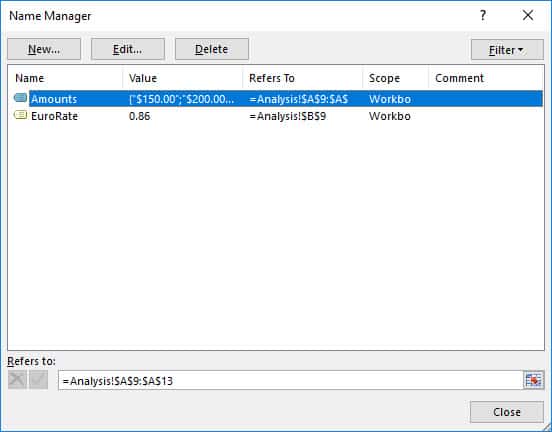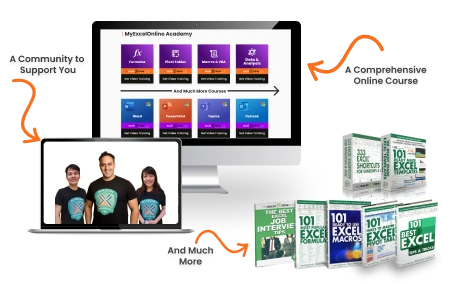Whenever I work with spreadsheets, there’s no escaping the fact that I have to work with a lot of ranges. Some of these ranges I have to reuse time and time again to create different calculations! Good thing there are Named Ranges in Excel! By using a Named Range, you can make your formulas much easier to understand, maintain, and reuse — without constantly referring to complex cell coordinates.
Let’s dive into what Named Ranges are, why they’re so useful, and how to create and manage them step-by-step.
Key Takeaways:
- Named Ranges let you assign meaningful names to cells or ranges for easier reference.
- Using Named Ranges makes formulas clearer, simpler, and less error-prone.
- Named Ranges can refer to cells, constants, formulas, or entire tables.
- You can manage, edit, or delete Named Ranges using the Name Manager.
- Named Ranges can be used in charts, data validation, and dynamic formulas.
Table of Contents
The Power of Named Ranges in Excel
What is a Named Range in Excel?
A Named Range in Excel is simply a name that you assign to a cell or a range of cells.
Instead of writing something like:
=SUM(A2:A10)
You can assign a name to that range, for example, “Sales”, and then use it like this:
=SUM(Sales)
This makes your formulas easier to read and understand — not to mention, far more professional-looking. You can also define a name for a constant, formula, or even an entire table, making your workbook more dynamic and flexible.
Why Use Named Ranges?
Before we jump into creating one, let’s quickly understand why Named Ranges are a game-changer in Excel.
- Clarity – Instead of referencing cells like C3:C15, you can reference Expenses. Anyone reading your formula will instantly understand what it does.
- Convenience – You don’t need to remember exact cell addresses. Just type the name and Excel knows what range you mean.
- Dynamic Updates – If you change your data, you can update the range in one place (Name Manager), and all formulas using that name will automatically reflect the change.
- Fewer Errors – Named Ranges reduce the risk of formula errors caused by referencing the wrong cell or range.
- Ease of Navigation – You can quickly jump to a named range using the Name Box or the Go To dialog (Ctrl + G).
How to Create a Named Range in Excel
STEP 1: Let us create our first Named Range.
Highlight the USD Amounts and type in the Name Box a name: Amounts
Make sure that there are no spaces. Press Enter.
Let us do the same to our Euro Exchange Rate. Highlight the exchange rate, and type in the Name Box a name: EuroRate
Press Enter.
STEP 2: Let us see our Named Ranges in action!
To calculate the Euro Amount column, type in: =A9 * EuroRate.
This will use our EuroRate Named Range!
Drag your formula below to the rest of the column to get the amounts calculated:
STEP 3: To calculate the sum of the Sum of USD column, type in: =SUM(Amounts).
This will use our Amounts Named Range!
And now you have your total!
STEP 4: If you want to check all the Named Ranges you created, go to Formulas > Defined Names > Name Manager
You can edit your Named Ranges in here or delete them as well.
Pro Tips for Using Named Ranges
Let’s level up a bit. Here are some practical tips to get the most out of Named Ranges in Excel:
- Use Descriptive Names – Use clear, meaningful names like TaxRate, Sales_2025, or EmployeeList. Avoid vague names like Data1 or Range2.
- No Spaces Allowed – Names can’t contain spaces. Use underscores _ or capital letters for readability (e.g., ExchangeRate_Euro or TotalSales).
- Names Are Not Case-Sensitive – Excel treats Sales, sales, and SALES as the same name.
- Absolute References – When you define a Named Range, Excel automatically creates it with absolute references (like $A$2:$A$10) so the reference doesn’t shift if you copy formulas.
- Use Names in Charts and Data Validation – You can use Named Ranges for:
- Chart data sources
- Drop-down lists in Data Validation
- Dynamic formulas like OFFSET and INDEX
- Jump to a Named Range Quickly – Use the Name Box dropdown or press F5 (Go To), then type the name — Excel will instantly take you to that range.
FAQs
1. What is a Named Range in Excel?
A Named Range is a user-defined name for a specific cell or range of cells. Instead of typing cell addresses like A2:A10, you can give that range a name, such as Sales. Named Ranges make formulas easier to read and maintain. They can also refer to constants, formulas, or tables, not just cells. Using them increases clarity and reduces errors in your spreadsheets.
2. Why should I use Named Ranges?
Named Ranges provide clarity, so anyone reading your formulas understands what the data represents. They are convenient because you don’t need to remember cell references. If the data changes, updating the range in Name Manager automatically updates all formulas using it. They also reduce errors caused by incorrect cell references. Overall, Named Ranges make spreadsheets more professional and easier to navigate.
3. How do I create a Named Range?
To create a Named Range, highlight the desired cell or range, then type a name in the Name Box (top-left corner of Excel). Press Enter to save it. Alternatively, you can go to Formulas > Define Name and assign the range a name via the dialog box. Make sure the name has no spaces and is descriptive for easier reference. Once created, you can immediately use it in formulas like =SUM(Amounts).
4. How can I use a Named Range in a formula?
Instead of referring to cell addresses, you can use the name you defined in formulas. For example, if you named a range EuroRate, you can calculate values with =A2*EuroRate. This makes formulas easier to read and update. You can also use Named Ranges in functions like SUM, AVERAGE, or IF. Dragging the formula down works normally, and it automatically applies the Named Range.
5. How do I manage or edit Named Ranges?
Excel provides a Name Manager to view, edit, or delete Named Ranges. Go to Formulas > Defined Names > Name Manager. Here, you can see all Named Ranges, their references, and scope. You can edit a range’s reference or delete it if no longer needed. This central management ensures all formulas using the range stay accurate and consistent.

Bryan
Bryan Hong is an IT Software Developer for more than 10 years and has the following certifications: Microsoft Certified Professional Developer (MCPD): Web Developer, Microsoft Certified Technology Specialist (MCTS): Windows Applications, Microsoft Certified Systems Engineer (MCSE) and Microsoft Certified Systems Administrator (MCSA).
He is also an Amazon #1 bestselling author of 4 Microsoft Excel books and a teacher of Microsoft Excel & Office at the MyExecelOnline Academy Online Course.















